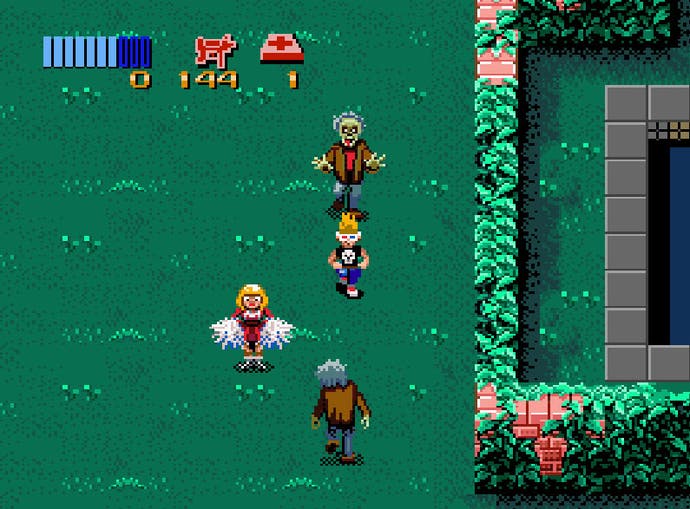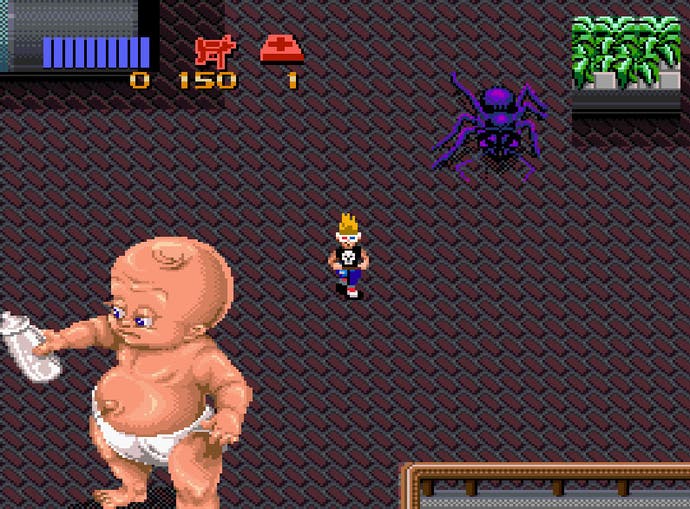Zombies Ate My Neighbors retrospective
Monster mash.
Release a game simply called Zombies today - as this Super Nintendo and Sega Mega Drive title was named in Europe - and the best reaction you could expect is a weary roll of the eyes as an undead-saturated medium groans at the very prospect of more shambling cadavers to wade through. The world was different back in 1994, though. Resident Evil didn't even exist back then, and the prospect of thinning the reanimated horde was still fresh. Or as fresh as a mobile carcass of rotten meat can be.
Zombies - or Zombies Ate My Neighbors, to use its full US title - wasn't really a horror game, though. At least, not in the blood and guts sense. Developed by LucasArts and published by Konami, it was a wonderfully witty and playful tribute to B-movie horror and sci-fi of all kinds. The titular zombies may form the baseline threat, but the game draws on every kind of monster and menace to ever loom over a drive-in.
In terms of construction, Zombies is, like so many older console games, deliciously simple. After choosing to play as either Zeke or Julie (or both, in two-player), you roam around maze-like levels looking for a stock set of suburban survivors. Reach them before the constantly spawning monsters do, or they get munched. Let all the survivors die and it's game over.

Having established such an intuitive baseline, Zombies very quickly starts layering a surprisingly deep system of weapons and items on top. A water pistol is your main weapon, ample for stopping a zombie with one shot, but later foes require more imaginative tools. This is, after all, a game where soda cans double as grenades and ice lollies are deadly. You can kill a werewolf with squirts eventually, but it'll die instantly if you throw some silverware. A weed whacker makes short work of alien plant life, while the roaming gelatinous creatures inspired by The Blob can be quickly dispatched in authentic movie style if you use the cold blast of a fire extinguisher.
Keys are needed to open doors, but you can also use a bazooka to blast them open, or just explode through weakened walls. Monsters can be distracted using inflatable clown decoys, while potions transform you into a hulking beast, capable of smashing all in your path.

The game walks a fairly bold line between humorous and serious. There's a cartoony look to the characters, but very little in the way of overt gags. Level titles have a tongue-in-cheek feel - "The Day The Earth Ran Away" or "Nightmare on Terror Street" - and some are introduced with lurid cinematic taglines, such as "More Shocking than Level 5! Level 6: Pyramid of Fear!"
The wit cuts deeper than that though. Take note of the hierarchy of victims you must rescue, which reflects the priorities of a suburban teen perfectly. The blond cheerleader nets you a full one thousand points, the hag-like teacher brandishing an F-graded essay a mere ten. There's a guy cooking at a barbecue, and if you pay attention to where the score actually appears, saving him is worth a mere five points but his juicy burger warrants a cool hundred.
There are the expected LucasArts nods, of course. Mr Lucas appears on the high score table - right at the bottom. There's even a bonus level based around Day of the Tentacle. Most of the parodies are more refined and skewed towards kids who grew up building Aurora model kits of the Wolfman or reading Famous Monsters of Filmland and Fangoria under their sheets with a torch. As mentioned previously, the blob of the game is The Blob of the movies by any other name. There are Body Snatchers and Gillmen, giant ants from Them! and bulbous-headed aliens who could have stepped straight off the set of Invasion of the Saucermen, a brilliantly obscure reference that only true B-movie geeks would think to include.
Zombies passes the test of any true classic - it's as much fun today as it was in 1994
It wasn't all '50s kitsch. For the kids of the '80s, there was a hockey-masked maniac wielding a chainsaw, at least if you played the US version. In Europe, the saw was replaced by an axe - apparently a much gentler tool of mass murder. There are even Chucky-style killer dolls who burst from their packaging and steam after you.
The music, too, is gloriously authentic, switching from gothic pipe organs and strident strings to eerie theremin sounds. Almost two decades later, the ghost train BWAH HA HA HA laugh that triggers when you press start is still burned into my brain.

Zombies passes the test of any true classic - it's as much fun today as it was in 1994. The collision detection is sometimes a little flaky, allowing you to miss items or victims that you could swear you were close enough to collect, and it's occasionally a little unfair, killing victims off-screen before you've even had a chance to find them. That it's still enormously entertaining despite those annoyances says a lot about how well tuned and appealing the central concept is. And with 48 levels, including bonus rounds, it's remarkably well paced too, introducing new monsters at regular intervals as the action bounces from suburbs to shopping malls, pyramids to castles.
It's notable that despite its simple recipe, few games have managed to repeat the Zombies formula successfully. Even its own sequel, the rushed and sadly charmless Ghoul Patrol, missed the subtleties that make the original so immediately entertaining - and the less said about modern riffs on the concept, like the dire Monster Madness, the better.
Zombies is one of those games that got it right first time, rendering any copycats or follow-ups surplus to requirements. Even now, when it seems that every game has to include the undead in some form, it distinguishes itself from the crowd.










